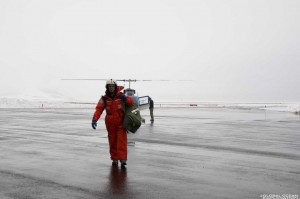The weather lifted a bit and the helicopter was able to start the transfer process from the ship. We eagerly awaited its arrival and hoped that the weather would hold long enough for all of us to get out. The helo holds three passengers with some cargo so we had to make three passenger trips and perhaps a few more with cargo.Â
We got word that the helo was on its way and we waited in the airport hangar for its arrival. Out of the fog, we heard the roar of the blades as the chopper landed. A few people off-loaded and our first group boarded and flew off. I was on the third trip so I was eagerly waiting the transfer. Finally I donned my mustang suit, a flotation suit we use for work on deck, and the special helmet. We loaded up the cargo and buckled ourselves in and flew off and over St. Paul. We had beautiful views of St Paul and its rugged coast as we flew below the low ceiling of visibility. The waves were crashing on the shore and the wind was howling but in a few minutes we were approaching the ship and beginning our landing on the helo deck. We had finally boarded the Healy to begin our work.Â
Â
Â
Once we were on board, we collected our belongings and began a tour of the ship. The USCG Healy is a huge ship, 420 feet in length. There are five decks and an overwhelming number of passageways. The ship is so large that I was issued a pager immediately upon boarding so that I could be reached if needed. All of the personnel have a pager for contact.Â
You can check out the ship at:
http://www.uscg.mil/pacarea/healy/
You can also see images of the bow from the “aloft cam†on the bridge of the Healy here:
http://mgds.ldeo.columbia.edu/healy/photos/aloftcon/2008/
After the tour, we met in the science lounge for a safety meeting where we were told what to do in case of emergency and the ins and outs of the ship. We found out where the life rafts are located and the survival suits. It is the Bering Sea so it is very cold and safety is very important.Â
We then had a science meeting where we met all of the scientists (there are about 50 scientists on board doing all kinds of amazing work) and the chief scientist, Dr. Carin Ashjian from Woods Hole Oceanographic Institution, told us the plan for the rest of the cruise. We have some very exciting things in store. We will stay in open water for a few days and then up north into the ice. The first sampling station was coming up at 0300. Â
Â


